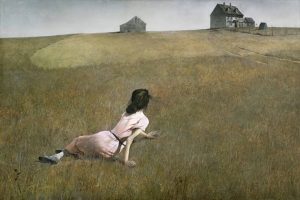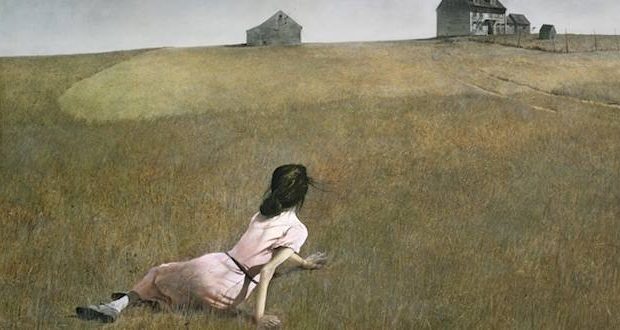The problem of evil has long been a challenge to Christians. How could an all-loving, all-powerful God allow pain and suffering in his good creation? The question never remains theoretical, of course. In one way or another, the problem will confront each us of directly. The question is, will we be ready when we get the inevitable phone call that brings us to our knees? What can we do today to ready ourselves for the heartache and pain of tomorrow?
It may be counterintuitive, but part of my answer is: Go to an art gallery.

Christina’s World is a 1948 painting by American painter Andrew Wyeth, and one of the best-known American paintings of the middle 20th century.
The arts have always been a key means of spiritual formation and renewal in the church. Art beckons us to look higher, to look deeper—to recognize the transcendent in items as ordinary as canvas and clay. This transcendent experience poses its own dilemma that is a sort of counterpoint to the dilemma of evil.
Just as evil causes us to ask, “How could this exist if there’s a God?” the goodness and order we see in art causes us to ask, “How could this exist if there isn’t a God?” Indeed, we’ll only be able to make sense of the world’s ugliness in moments of crisis if we first try to make sense of the world’s beauty in moments of transcendent joy. Dealing with the problem of pleasure will prepare us for the problem of pain.
We’ll only be able to make sense of the world’s ugliness in moments of crisis if we first try to make sense of the world’s beauty in moments of transcendent joy.
Seeing Beyond
The great conductor and composer Leonard Bernstein put it beautifully:
Beethoven turned out pieces of breathtaking rightness. Rightness—that’s the word! . . . Our boy has the real goods, the stuff from heaven, the power to make you feel at the finish: something is right in the world. There is something that checks throughout, that follows its own law consistently: something we can trust, that will never let us down.

The Scream is the popular name given to multiple versions of a composition by Norwegian Expressionist artist Edvard Munch.
In the Christian account of the world, creation is sacramental: it points beyond itself. But if we haven’t trained our eyes to look for order and meaning in the symphony, we won’t be likely to see with eyes of faith in the midst of tragedy. So, be it a piece of music, a painting, a sculpture—all art should lead our eyes beyond the immediate and to the infinite, beyond the creation itself to the Creator himself.
This is a point C. S. Lewis makes in The Weight of Glory:
The books or the music in which we thought the beauty was located will betray us if we trust to them; it was not in them, it only came through them, and what came through them was longing. These things—the beauty, the memory of our own past—are good images of what we really desire; but if they are mistaken for the thing itself they turn into dumb idols, breaking the hearts of their worshipers. For they are not the thing itself; they are only the scent of a flower we have not found, the echo of a tune we have not heard, news from a country we have never yet visited.
In the secular, de-mythologized West, our eyes are taught to look at and in, but never through, and certainly not up. Whatever you call this cultural phenomenon—objectivism, scientism, utilitarianism—its effects are palpable: we’re habituated to see creation as mere nature, an end in itself, an object for dissection but certainly not delight.
In such a culture, appreciating art takes more discipline and effort than ever before. At first, the clay appears to be just that: a lump of dirt. Yet if you make it your practice to stop by the same sculpture each time you visit the museum, over the months and years you will
Maggie Swofford is a blogger and, in a helpful response to this article, provided her own tips on viewing art though the lens of suffering. “Research the art or the artist that you’re looking at. The artist’s life story, while not always relevant to the piece, can sometimes be just as inspiring as the work of art itself. Try to avoid shying away from art that makes you uncomfortable. There’s beauty in everything, including the raw expression of someone’s hurt. Sit in the ache of that manifestation. Avoid shying away from the communication of your own agony. We were made with emotions, and it pleases God when we bring those feelings to him in prayer or in a creative way, such as writing, poetry, music, painting, knitting, and so on.”
To see more than a lump of dirt in a sculpture takes patience that is rarer and rarer in our fast-paced age.
The thing is, seeing well takes intentionality, especially in our distracted age. To see more than a lump of dirt in a sculpture takes patience that is rarer and rarer in our fast-paced age. But if we as Christ’s followers want to honor God’s beautiful creation (including the creations of his image-bearers), we need to cultivate this patient mode of seeing.
Problems of Pain and Pleasure
The conditions that make art appreciation difficult are the same conditions that make reckoning with the problem of evil difficult. The same eyes that see only a lump of clay in a sculpture will only see discoloration and scars when looking in the mirror after a major surgery. Conversely, eyes trained to see meaning and beauty while sitting on the museum bench will be able to recognize the handiwork of God while lying in the hospital bed, even as they yet see through a glass, dimly.
This is not to say we will always discover meaning just by looking at something hard enough. Meaning in art, as in suffering, is sometimes elusive or even inaccessible. The death of a loved one or relentless hardship can often feel senseless, absurd, devoid of meaning. Some overly artsy music or films can feel the same way. But the extremes do not detract from the broader principle. The more we cultivate intentional, observant viewing of art, the more we’ll be able to make meaning of all of reality.
The arts are crucial in recovering the skills necessary to regain a right disposition toward reality. They can help us see order and cohesion in the true, the good, and the beautiful. Not only can a deep familiarity with the beautiful give us the standard by which we recognize and name the ugly, but once we’ve become accustomed to looking for meaning in moments of joy, perhaps we can also see with eyes of faith in moments of despair.
We might say it this way: The problem of pain becomes more manageable if we’ve already reckoned with the problem of pleasure.
By Dustin Messer. Dustin leads young adult and college ministry at All Saints Dallas and teaches theology at Legacy Christian Academy in Frisco, TX. Additionally, Dustin serves on the board of directors at both the Evangelical Fellowship in the Anglican Communion (EFAC-USA) and the Center for Christian Civics in Washington, DC. Before starting his doctoral work at La Salle University, Dustin graduated from Boyce College and Covenant Theological Seminary and completed a fellowship at the National Review Institute.
 Metro Voice News Celebrating Faith, Family & Community
Metro Voice News Celebrating Faith, Family & Community 








